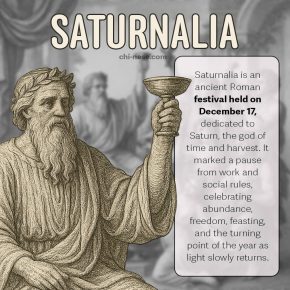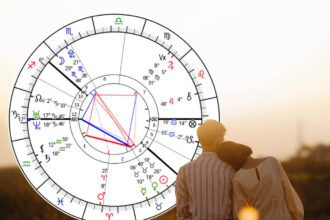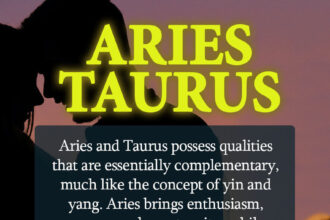Astrology is full of fascinating patterns, from clusters and grand crosses to kites and grand trines. But few are as mysterious or as debated as the Yod, often called the “Finger of God” or “Finger of Fate.” If you’ve discovered one in your chart (or someone else’s), you might be wondering what it actually means and how it might eventually manifest in your life. More importantly, will you actually feel it?
Let me start by saying this: Yods are strange. Some people swear by their life-altering significance, while others barely notice them. If you have a tight Saturn square Moon or Pluto square Sun, you’ll feel those themes in your life whether you want to or not. But a Yod? You might sense its influence… or you might not. And that’s largely because of the quincunx, the odd angle at the core of a Yod, which can be incredibly subtle or suddenly very noticeable.
Over the years, I’ve read hundreds, maybe even thousands, of charts. I’ve seen people with one Yod, some with two, and a few with three. And the way they manifest? Never the same twice.
What Exactly Is A Yod?
A Yod is a unique (though not necessarily rare) astrological pattern shaped like a long, narrow triangle, or a celestial slingshot. It forms when:
- Both of those planets form quincunxes (150° angles) to a third planet, the apex.
- Two planets are sextile (60° apart).

If you use Astro-Seek or Astro.com, you’ll spot it easily: two long green lines (the quincunxes) pointing to one planet, connected by a short blue line (the sextile).
Each part of the Yod contributes a different flavor:
- Sextiles create easy flow and potential.
- Quincunxes bring tension and adjustment.
Together, they create a kind of cosmic pressure point. The apex planet, where those two green lines meet, becomes the focal point of the configuration. It carries the mission, the pressure, or sometimes the frustration of the whole pattern.
Traditional astrologers focus only on planetary Yods, but modern astrologers often include the Nodes, Chiron, or even Lilith. Personally, I consider them all, because a Yod involving Pluto, Saturn, and Lilith at the apex can be far more intense than one with Venus at the apex.
What a Yod Feels Like
If I had to describe a Yod’s energy, it would be one of two things:
1. The Sleeping Giant. There’s a hidden gift or dormant ability that takes years to fully awaken, often triggered by transits or life events.
2. The Divine Push. It can feel like being steered (sometimes gently, sometimes not) toward a purpose you didn’t choose but can’t quite ignore.
That’s why it’s called the Finger of God: it points, often insistently, toward something you’re meant to do or realize.
Still, it’s important to remember: not everyone experiences their Yod dramatically. For some, it’s background noise until one day, suddenly, it isn’t.

The Apex: Where the Story Unfolds
The apex planet is the heart of the Yod, the focal point where all the energy converges. Whatever planet sits there tends to dominate the story.
Here are a few examples:
- Apex Moon: emotional twists, psychic sensitivity, sudden changes in home or family life. These people often feel “tuned in” to energies others miss.
- Apex Mars: bursts of motivation, restlessness, frustration that demands direction. The drive can be powerful, but it needs focus.
- Apex Neptune: heightened intuition, creative surges, or spiritual confusion. You might drift until you learn to channel inspiration instead of chasing illusions.
Sometimes, the apex planet can feel like a pressure valve, the spot where life keeps pushing until you integrate it consciously.
Do You Feel Your Yod? Maybe… or Maybe Not.
Unlike hard aspects (squares or oppositions), which are hard to ignore, a Yod can be subtle, even dormant. It often activates only when a major transit or progression hits the apex planet.
When that happens, you might suddenly understand what it’s been building toward all along.
Here’s what affects how much you feel it:
- Transits and progressions: Outer planets (Pluto, Uranus, Saturn) activating the apex can make the Yod “wake up.”
- Self-awareness: Someone who reflects or journals may spot Yod patterns early; someone more pragmatic might dismiss them as coincidence.
- Houses: A Yod in the 12th house may work quietly in the background, while one in the 10th could bring visible career or reputation shifts.
Some people describe it as a lifelong “calling” that doesn’t make sense until later or a strange sequence of events that, in hindsight, feels fated.
Real-Life Examples
Person A (76 years old): Venus sits at the apex of her Yod. She never married, never had children, and never pursued romantic relationships, yet from a young age, she displayed extraordinary artistic talent and became a published writer. It’s as if fate redirected Venus’s creative power inward, trading personal love for creative mastery.
Person B (42 years old): Sun at the apex. Since her teens, she’s been obsessed with altering her appearance, countless cosmetic surgeries and aesthetic procedures. The Sun in her 1st house, tied to identity and physical appearance, forms the Yod’s focal point, with Pluto and Uranus at its base. The pattern seems to manifest as an ongoing struggle for self-acceptance through transformation, but also as deep instability.
Person C (31 years old): A singer with three Yods. Before her Saturn return, around age 29, she was diagnosed with lung cancer. Over the following two years of treatment, her life changed drastically, she lost a significant amount of weight, and her voice transformed due to her condition.
She has two Yods involving Pluto and Uranus, and Pluto and Neptune, both forming quincunxes to Venus in Gemini (Apex). The third Yod connects Mars and Venus, with Pluto as the apex, along with her North Node, since her natal Pluto and North Node are conjunct.
In her chart, the Yods link Capricorn, Scorpio, and Gemini, highlighting themes of speech, voice, artistry, and even the lungs themselves, all ruled by Gemini.
All three have Yods, yet each expresses the energy in a completely different way.
How to Interpret a Yod (Without Losing Your Mind)

- Identify the Apex Planet. This is where everything funnels. Understand what that planet rules and represents in your chart. Mercury governs thought and speech, Venus governs relationships and aesthetics, Saturn governs structure and discipline, etc. If it’s also your chart ruler (for Taurus or Libra rising, that’s Venus; for Gemini or Virgo rising, Mercury), it’s even more significant.
- Examine the Supporting Planets (the sextile pair). These two planets work together and “feed” into the apex. Are they harmonious, or do they carry tension? For example, Mars sextile Pluto feeding into Neptune can create explosive creativity or obsession with ideals.
- Check the Houses. Where does this dynamic play out? A Yod involving the 6th house might show up as chronic work or health challenges; one in the 10th might play out publicly through career or reputation.
- Watch for Transits. Heavy transits (Pluto, Saturn, Neptune, Uranus) to the apex planet often mark major turning points or awakenings.
Pro tip: Don’t force meaning if nothing’s happening. Yods often make sense only in hindsight, like realizing a strange series of events was part of a much bigger pattern.
Beyond Planets: Non-Planetary Yods
Traditional astrologers often insist a Yod must involve three planets, but I take a broader view. Points like the Nodes, Chiron, and Lilith can absolutely shape a Yod’s story, especially if they sit at the apex or form one of the base points.
The Ascendant (ASC), Midheaven (MC), and other angles also count… they’re not “objects,” but they’re deeply personal and highly sensitive.
Keep the orb tight, about 3°, maybe up to 5° if personal planets or especially luminaries are involved.
Fate or Just a Quirk?
Astrologers have argued about this for decades: are Yods fated, karmic, or simply odd configurations that look more dramatic than they are?
My take: a Yod marks something unresolved, a tension seeking direction. It’s neither pure fate nor random chaos. It’s potential energy waiting to be aimed.
Some people experience recurring “Yod moments”: sudden changes, synchronicities, or pivotal choices that seem to redirect their life path. Others hardly notice it until much later. Both experiences are valid.
Astrology is a tool for awareness, not a script you’re forced to act out.
Should You Worry About Your Yod?
Not at all. But should you explore it? Definitely. A Yod is an astrological pattern that speaks of fate, destiny, and the turning points that shape who you become. It points to areas of life where something deeper is unfolding, a purpose, a lesson, or a pattern quietly guiding you back to yourself.
But even if it doesn’t scream destiny, your Yod can reveal fascinating layers of purpose and timing. Track it through transits, reflect on patterns, and see if its themes echo across your life.
From my experience as an astrologer, I’ll say this: never isolate one pattern. A Yod is one piece of a much bigger story. Squares, oppositions, conjunctions, they all matter just as much.
So if you’ve found a Yod in your chart, don’t panic, get curious. Watch how it plays out. And remember: in astrology, as in life, what you do with your awareness is far more important than the pattern itself.












